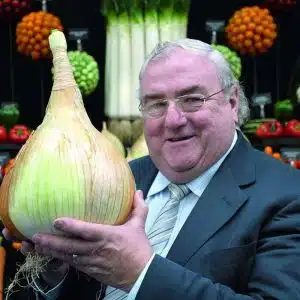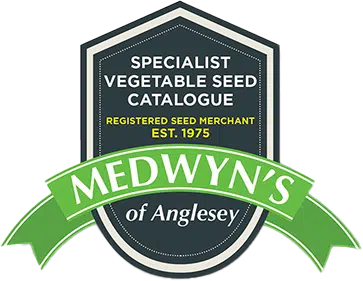Home - What to do with a four pound Onion!

Medwyn Williams
Hello. I'm Medwyn Williams – eleven times Gold medal winner at the Chelsea Flower Show, Past Chairman of the Royal Horticultural Society Fruit Vegetable and Herb Committee and President of the National Vegetable Society.
What to do with a four pound Onion!
What do you do with an onion that measures over 20 inches in circumference and weighs nearly four pounds?. If you have yards of cling film and a big chunk of cheese then you can keep it in the fridge and make yourself and your friends lots of sandwiches. Well, last year I had the answer when I was asked by a Welsh TV company if they could visit my garden with their Welsh language cooking programme ‘Dudley” which is hosted by one of Wales’ top chefs, Dudley Newberry.
A number of people who can not grow large exhibition onions very well always seem to say that they are not worth bothering with as they don’t keep. Well, I have kept them through to March in my garage and with the aid of a cold store in Bangor I have kept through to the end of May when they have been staged at Chelsea. They also often say that they have no taste or flavour, personally I find then just perfect, they are not too hot and have a nice sweet taste.
Welsh TV
However the biggest question is, what do you do with an onion that measures over 20 inches in circumference and weighs nearly four pounds?. If you have yards of cling film and a big chunk of cheese then you can keep it in the fridge and make yourself and your friends lots of sandwiches. Well, last year I had the answer when I was asked by a Welsh TV company if they could visit my garden with their Welsh language cooking programme ‘Dudley” which is hosted by one of Wales’ top chefs, Dudley Newberry.
Preparing a Dish
Prior to him visiting my garden I set him a challenge to make a dish out of one of my big onions. When the crew arrived, with their own mobile kitchen, I walked around the garden with Dudley looking at different vegetables that I had growing at the time. For the cooking he selected a leek, one of my long carrots, a yellow carrot, a few salad blue potatoes (that are blue inside) a few Pink fir apple potatoes some parsley and of course a big onion. The onion selected was over 21 inches in circumference and thankfully, when Dudley cut through it, it was perfect inside.
The next step was to remove the top which was later used as a lid, then the inside was all scrapped out with 50% of it being cooked to refill the onion afterwards. The meat used was minced welsh lamb cooked with added herbs and leeks and the potatoes were par boiled. The onion was filled in layers of Pink fir apple potato and mince and the top slice of onion was then replaced on top as a lid. The whole onion was then brushed over with oil, placed in a dish lined with aluminium foil and cooked in the oven until the outer skin was nice and brown.The result was absolutely delicious and Dudley is welcome to come back to my garden any time he likes to create some more special dishes with my show vegetables. I wonder if you have a special recipe that makes use of your large onions, please let me know.
This Year’s Onions
I hope to have my large onions planted this coming week in my far tunnel which has three raised beds constructed in it. One of the beds will grow 40 onions for the under 250 gram classes and other two will be for my own re selected large exhibition ones. Twenty of the small onions will be the ones that I have grown from bulbils from the best F1 Tasco onions that I had two years ago. The vigour in the plants is amazing, they are far stronger and sturdier than those grown from seed, however time will tell if the exercise has been successful. The main purpose was to try and get a more even set from fewer specimens, and as these are effectively clones off the one mother plant, they should all be the same. The other twenty onions are going to be Friso.
The Beds
The beds have all been well rotovated and fertilised a few weeks ago and all I have to do now is to rake it level and then sink into the soil the same size and shape pot as the plants are growing in, spaced out at 20 inches apart minimum. Seeping hoses will be laid down next, in my case I have one narrow bed which will have a single row in it and the other wider bed will have two rows. The single row will have a hose on either side and the double row will have three hoses. The next step is to scatter a few slug pellets on top prior to covering the bed over with black and white polythene, the white surface facing upwards. For the benefit of novice growers, the polythene has many functions, it keeps the moisture in the bed so you don”t have to water that often, it also throws up a high percentage of light on to the foliage thereby increasing the growth rate. Another function is as a weed suppressor, no more hoeing to be carried out and finally it keeps the soil relatively cool should we have a hot summer.
Make sure the polythene is either tucked into soil around the edges or, if you have raised beds, leave it overhanging the sides thereby giving you increased light into the tunnel. (picture attached) One word of warning though, if you haven’t got any soil warming cables installed to maintain a minimum temperature of 60°F, the polythene will lower your soil temperature. Just as the white colour has the added benefits of reflecting light and heat during hot Summer months, the very same action during early spring lowers the soil temperature by about 5°F.
Finally once the polythene has been laid out and anchored, you can then feel through it for the position of the pots and using a sharp knife, cut two slits from corner to corner of each pot. The white flaps can then be tucked under the polythene and the onion plant carefully dropped into the pre shaped hole. Water around each one, giving roughly a pint of water each, just to settle the surrounding soil around the root ball. I like to leave the plastic plant support clips on for a couple of weeks before removing them after the plants are noticeably growing away.
